Mine Action and Food Security: The Complexities of Clearing Ukraine’s Agricultural Lands
By Markus Schindler and Anthony Connell [ Fondation suisse de déminage, FSD ]
CISR JournalThis article is brought to you by the Center for International Stabilization and Recovery (CISR) from issue 27.2 of The Journal of Conventional Weapons Destruction available on the JMU Scholarly Commons and Issuu.com
Over the past decade, peace has eluded Ukraine. The annexation of Crimea and a separatist insurgency—sufficiently concerning in their own right—proved to be a mere prelude to Russia’s full-scale invasion of Ukraine in February 2022. The largest land-war that Europe has seen since the Second World War is causing immense human suffering, devastating destruction, and extensive explosive remnants of war (ERW) contamination. Mines, submunitions, and unexploded ordnance (UXO) continue to cost the lives of countless civilians and the death toll is rising by the day. Mine action organizations such as Fondation suisse de déminage (FSD) are working in Ukraine to clear these hazardous remnants of war and to prevent and mitigate their impact on Ukraine’s people and infrastructure. This article provides an overview of FSD’s operations in Ukraine, both prior to and during the war. It particularly emphasizes FSD’s work to clear Ukraine’s vital agricultural areas, highlighting the intricate link between mine action and food security. The article also underscores some of the key challenges that FSD has encountered while working in war-torn Ukraine.

A handwritten sign indicates the presence of a mine under this box, Andryivka, November 2022. All images courtesy of the authors.
Brief History of Contamination
Like many other European countries, Ukraine has been grappling with ERW dating back to World War II. However, this “legacy” contamination pales in comparison to the explosive ordnance (EO) left behind during various phases of armed conflict that started in 2014 and culminated in the invasion of Ukraine by neighboring country Russia. Today, towns, agricultural lands, and seaways across Ukraine are littered with a wide range—and enormous quantity—of ERW, including anti-personnel and anti-vehicle mines, sea mines, large amounts of cluster munitions, thermobaric weapons, and other unexploded or abandoned ammunition, with the highest concentration found in the eastern and southern parts of the country.1 These explosive hazards present a high risk to the lives and limbs of civilians—a risk that, all too often, turns into grim reality.
FSD in Ukraine Before the War
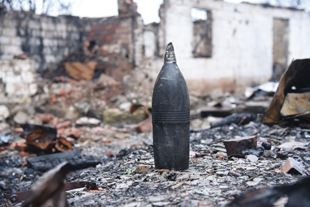
Contamination in Kharkiv, November 2022.
FSD has been involved in Ukraine since early 2015, specifically in the Donbas region along the line of contact separating the Ukrainian government-controlled area and the separatist-controlled area. At first, FSD's teams focused on emergency risk education campaigns, aiming to significantly reduce civilian casualties. This was achieved by teaching the conflict-affected population to live with the presence of mines and UXO until the surrounding land could be cleared. Subsequently, FSD's survey teams began assessing the ERW contamination in eastern Ukraine. In 2016, around fifty local staff were recruited, trained, and deployed from operational bases in Sloviansk and Mariupol to begin demining work. Over the next few years, these teams investigated numerous former battlefields, successfully locating hundreds of UXO. Additionally, FSD provided support to Ukrainian institutions to establish a national mine action authority.2
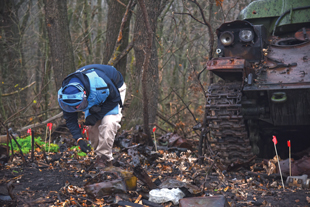
FSD teams marking EO in eastern Ukraine, November 2022.
During the armed conflict in Ukraine, FSD faced a challenge in accessing affected populations in the nongovernment-controlled area (NGCA) in the country's far east. To mitigate the risk of accidents with ERW, FSD utilized two methods for explosive ordnance risk education (EORE). The first involved direct contact with people from the NGCA at checkpoints located along the contact line, while the second approach employed a digital campaign through various social media platforms. FSD reached over 367,988 adults and 78,433 children in the NGCA with EORE messages from 2020 until 2022. Due to the outbreak of war and international sanctions, digital EORE in the NGCA became infeasible. However, FSD continues its digital EORE campaign in Ukraine's government-controlled area through social media platforms such as Instagram, particularly targeting users under the age of eighteen in newly reclaimed and conflict-affected areas.
FSD’s Reaction to the War
FSD responded promptly to the unexpected and forceful Russian invasion of Ukraine by taking measures to safeguard its staff and activities. Despite being caught off guard by the scope, rapidity, and intensity of the invasion, FSD quickly evacuated crucial equipment from Mariupol to Sloviansk and ceased all field operations and travel outside of these two locations for a period of two weeks. To offer its Mariupol-based personnel flexibility, FSD gave its eighteen employees there the choice to remain in place or leave, which some did while others stayed. As telephone networks were progressively shut down and the city's electrical supply was curtailed, communication with the remaining Mariupol staff became increasingly challenging. Tragically, one FSD staff member was killed in his hometown of Mariupol during the intense assault on the city. FSD's office suffered significant damage and two pickups that FSD had left in Mariupol, in anticipation of the possibility of staff needing to relocate, were lost.
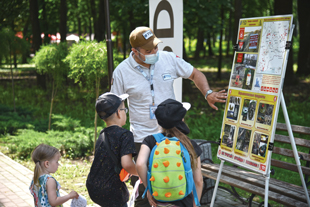
FSD conducting EORE for school children in Kramatorsk, June 2021.
Responding to the enormous need in the immediate aftermath of the onset of war, FSD shifted its focus from mine action to humanitarian assistance, particularly targeting people evacuating from the Donbas area and internally displaced persons (IDPs) in evacuation centers. Additionally, FSD continued its EORE outreach. While face-to-face sessions were difficult to conduct, FSD published material on various social media platforms.
In addition to adapting its operations to the changing circumstances, FSD also coordinated with national authorities and donors to ensure a seamless transition. FSD’s donors displayed extraordinary levels of flexibility and support, and FSD’s accounting team reduced much of the routine requests during these trying months, which proved helpful in streamlining processes and coping with sudden changes. The Sloviansk office was eventually fully evacuated as the war progressed, but FSD was able to stay in country, continue its work, and adapt to the new realities of the conflict.
Return to Operations
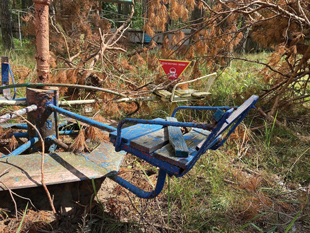
Destroyed playground in Chernihiv, 2022.
By mid-2022, the situation in Ukraine had stabilized enough for FSD to return to its pre-war operations. FSD still had existing funding, and funds that were put on hold at the start of the war were allowed to flow once again. FSD’s donors agreed to shorten existing funding timeframes to allow for a significantly expanded new project, reflecting the vastly increased need following Russia’s invasion of Ukraine. New donors approached FSD, offering to fund additional teams. Thanks to the support and flexibility of FSD’s old and new donors, the new project had funding for seven battle area clearance (BAC) teams, one mechanical team using a Dok-Ing MV-4 ground preparation machine, two rubble removal teams (each rubble removal team consisting of an armored excavator, an armored front-end loader, and a tipper truck), three non-technical survey (NTS) teams, and three risk education teams. Most of these teams, as well as FSD’s support teams, are staffed with both women and men.
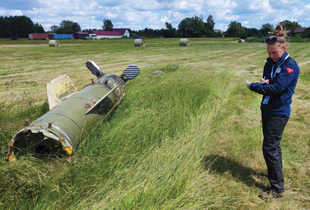
An FSD investigator records the specific condition of a localized explosive device,
April 2022.
Expansion of Operations and Team
Due to shortages in funding in the pre-war period, as well as losses in the early stages of the war, FSD had reduced equipment and was forced to restart with the procurement process—a major task considering that FSD’s operations and staff numbers were increasing significantly. Of the more than fifty staff that were with FSD before the war, twenty-four continued to work with or returned to FSD, including many senior staff members in both operational and support roles. As a result, FSD was able to set up a new country office and restart operations in a relatively short timeframe, while continuously recruiting and training new staff.
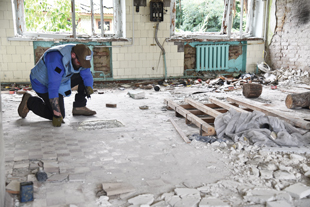
Deminer inspecting a building in Chernihiv, September 2022.
Years of local experience have taught FSD that the onset of winter in Ukraine can be sudden and harsh, so restarting operations as soon as possible was crucially important. By mid-August 2022 and with the war in full swing, FSD teams were on the ground delivering EORE, conducting NTS, and working on explosive ordnance disposal (EOD) spot tasks—all while continuing to recruit and train new staff; and, slowly, the required equipment continued to trickle in.
After re-locating FSD’s office from eastern Ukraine to Chernihiv, an embattled but reclaimed area north of Kyiv, FSD’s teams engaged in rapid response spot tasks due to the large amount of surface contamination.3 From there, FSD’s teams deployed further east to Izium in Kharkiv Oblast. The city saw heavy fighting during 2022 but was eventually liberated by Ukrainian forces. The picture that presented itself to FSD’s teams in Izium was grim: The large-scale destruction, obliterated villages, and cratered streets, littered with burned out military and civilian vehicles, was reminiscent of images from the Second World War. Over 70 percent of multi-story buildings in Izium were devastated, alongside the destruction of over 80 percent of infrastructure, including the centralized heat supply system.4 FSD staff cleared numerous destroyed military vehicles, cars, hospitals, and schools. In the span of less than four weeks FSD’s teams were able to mark, move, or clear 542 items of EO.
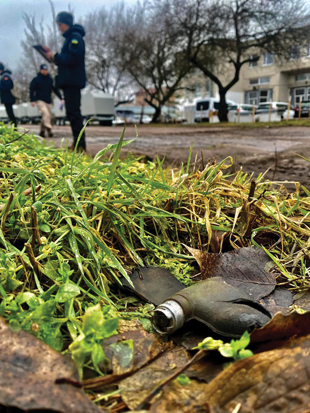
PFM-1 anti-personnel mine (otherwise known as a butterfly mine) next to a road in Kharkiv Oblast.
By the end of October 2022, the fighting in most other areas of Kharkiv Oblast had stopped and the Ukrainian forces had liberated the area. FSD immediately sent two EOD spot task teams, a risk education team, and an NTS team into Kharkiv Oblast to utilize the last operational month before the onset of winter.
During the winter stand-down, the Geneva International Centre for Humanitarian Demining (GICHD) organized a donor conference that allowed the Ukrainian authorities to elaborate on their country’s most pressing needs. The conference succeeded in highlighting Ukraine’s mine action priorities, and in garnering additional donor support. FSD has since re-activated a standby agreement with the World Food Programme (WFP) that saw FSD collaborate with WFP in the early 2000s.5
Field operations resumed once the harsh winter conditions relented in mid-March 2023. By then, FSD’s donors, content with FSD’s operations in 2022, made available additional funding for another twelve months, which required FSD to expand once again. By the start of field operations in 2023, FSD’s team had grown from seven to thirteen internationals, and from ninety-five to about 170 national staff.
Importance of Ukraine’s Agricultural Sector
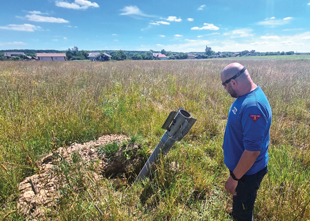
Contaminated agricultural fields around Chernihiv, April 2023.
Ukraine is often considered one of the world's great “bread baskets”—the country of 41 million inhabitants produces enough food to nourish 400 million people around the globe, making it one of the world's largest exporters of agricultural products.6 Ukraine’s significance to global food security is indisputable: The country has vast arable land, fertile soil, favorable climate conditions, and a highly skilled agricultural workforce, which has enabled it to become a major player in the global agricultural market. Ukraine is the world's largest exporter of sunflower oil and one of the leading exporters of corn, wheat, and barley. The country's agricultural products are exported to markets in Asia, Africa, Europe, and the Middle East, contributing to global food security by providing a reliable source of affordable and high-quality food products. However, years of insurgency and warfare, and the resulting contamination with EO, have severely hampered Ukraine’s ability to maintain previous levels of agricultural production and global distribution. This is felt in many parts of the world, particularly in regions reliant on food imports to meet domestic production, such as many countries in North Africa and the Middle East.7
FSD’s operations in Ukraine, particularly the clearance of agricultural lands, impact all three sectors of the humanitarian-development-peace nexus (commonly referred to in the mine action sector as the “triple nexus”).8
Humanitarian. Mine action is a critical component of humanitarian work in Ukraine. The presence of mines, UXO, and other ERW in the country has led to countless deaths and injuries, with civilians, in particular, being at risk. Local officials have reported numerous EO accidents with farm workers that resulted in deaths and injuries, and media reports bring to light the highly dangerous practice of desperate farmers who remove mines and UXO from their land without any training or proper equipment.9 The professional clearance of mines and other explosive hazards therefore not only saves lives but also helps to create safer communities, enabling people to return to their homes and rebuild their lives. EORE campaigns provide people with the knowledge and tools necessary to protect themselves and their families from explosive hazards, which contributes to the protection of human rights, including the right to life, liberty, and security of person.
Development. Years of insurgency and warfare, and the resulting contamination with EO, have severely hampered Ukraine’s development.10 By clearing contaminated agricultural land, FSD and other mine action organizations in Ukraine seek to enable farmers to return to their work and to cultivate their crops, ultimately aiming to stimulate economic and human development on the local level and contribute to Ukraine’s recovery. EO clearance thereby plays an important role in linking short-term humanitarian relief with medium-term rehabilitation and sustainable long-term development.
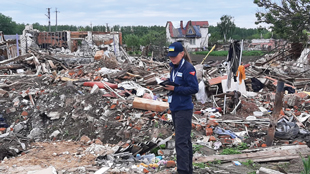
Non-technical survey in Chernihiv, 2022.
Peace and Security. Econometric research shows strong evidence of a positive correlation between increases in food prices and the probability of protests, riots, or social unrest.11 By clearing Ukraine’s vital agricultural land, FSD and other mine action actors are not only helping Ukraine to meet the increasing demand for food and ensuring food security in many parts of the world; FSD’s clearance of Ukrainian farmland is also making an important contribution to peace and stability in regions far beyond Ukraine’s borders.
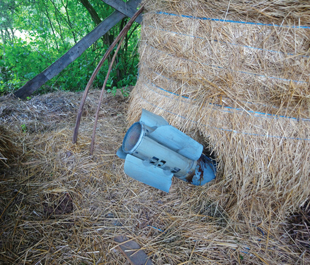
Ammunition on a farm in Kukashivka, Chernihiv, July 2022.
Triple Nexus. The contamination of Ukraine’s agricultural land is an explicit indicator that mine action increasingly sits across the three sectors of humanitarian, development, and peace and security efforts. FSD's long-term strategy has clearly realized these linkages and encourages the integration of mine action in the wider triple nexus programming. The organization recognizes that durable peace and sustainable development cannot be achieved if the natural resources sustaining livelihoods and ecosystem services are damaged, degraded, or destroyed. On the contrary, environmental protection and the sustainable management of resources are important pathways to consolidate peace and promote longer-term development.
Environment. FSD recognizes that the presence of ERW and other pollutants has a direct and long-term impact on the environment. To address this issue, FSD is promoting the integration of its mine action activities with environmental land remediation and protection efforts. Consequently, FSD's environmental activities are focused on post-clearance and/or decontamination land use, which links to socio-economic development in affected regions. This approach aims to support the rehabilitation of communities, enhance food security, and build climate change resilience, particularly for vulnerable and poor populations.
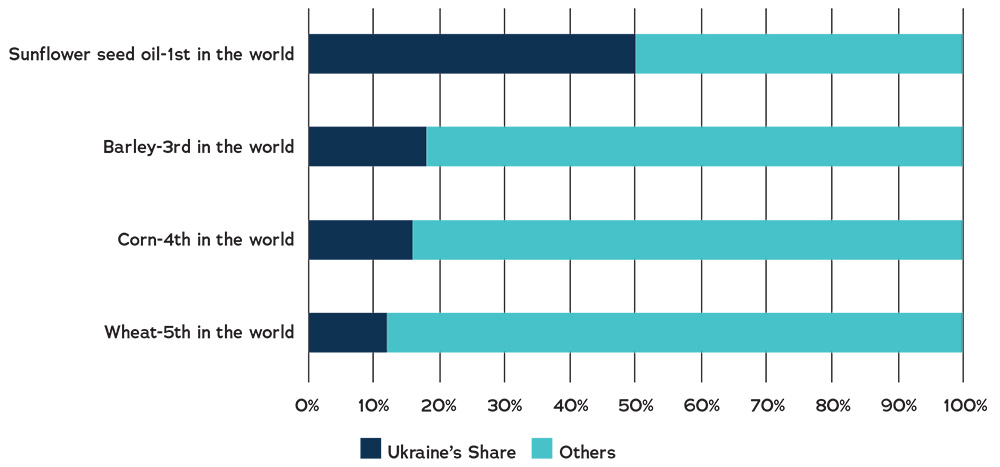
Figure 1. Ukraine's share of the global exports and worldwide ranking before the Russian invasion. Sources: European Commission, FAO (Food and Agriculture Organization of the United Nations), International Grains Council, Ministry of Agrarian Policy and Food of Ukraine. Council of the EU and European Council, “Infographic - How the Russian invasion of Ukraine has further aggravated the global food crisis,” Council of the EU and European Council, 2 December 2022, accessed 10 April 2023, https://bit.ly/41A9IMJ.
Clearance of Agricultural Lands
As shown in Figure 1, the clearance of ERW from agricultural land is essential for local recovery, national development, and global food security. It allows farmers to return to their fields and plant crops without fear of injury or death, thereby reclaiming arable land for food production—ample reasons for FSD to make the clearance of Ukraine’s agricultural land a priority. To do so, FSD has acquired a remote-controlled Dok-Ing MV-4 mechanical clearance asset and a larger MV-10 clearance machine, both with flails and tillers, and is planning to import more demining machines of similar size. Having received the required accreditation from the Ukrainian authorities, FSD has since deployed its machines and commenced with the mechanical clearance of Ukraine’s agricultural lands.
FSD recently established operations in Mykolaivska, in the southeast of Ukraine, on request of the Ukrainian Mine Action Authority. One of the country’s key agricultural centers, this area was liberated by Ukrainian forces in 2022. However, resulting from offensives and counteroffensives, Mykolaivska remains heavily contaminated with EO. After conducting a reconnaissance visit, FSD dispatched two NTS teams and is preparing to deploy initial BAC teams to the region. Thanks to continued and increasing funding from various donors, FSD’s clearance operations of agricultural lands in Mykolaivska continue to grow steadily.
As a result of the invasion and EO contamination, most of the liberated areas are struggling with high unemployment rates.12 This is why FSD, wherever possible, recruits national staff from these local areas. This helps both FSD and the local population: Local staff know the area, and employing and training them helps to put money back into the local economy. However, employing local staff requires a new mobilization phase every time FSD moves to a new area, which, primarily because of the often insufficient availability of clearance equipment, can take up to three months.
FSD recognizes the potential of modern technologies, such as drones and satellite imagery, to enhance the effectiveness and safety of NTS in mine action. The use of drones equipped with high-resolution cameras and sensors allows for rapid and efficient aerial surveys of large areas, such as Ukraine’s vast agricultural lands, providing valuable information on potential EO contamination, which can be used to prioritize and plan clearance operations. In addition, the use of drones can minimize the risks associated with conducting NTS in hazardous or challenging areas.
To leverage the potential of these technologies, FSD has been collaborating with “FindMine,” a cooperative R&D project between a Swiss foundation and various Swiss and German universities that has developed an unmanned aerial vehicle (UAV)-based sensor system for mine detection.13 The discussions aim to identify and explore the latest developments in the use of drones for mine action, as well as to identify best practices and lessons learned from previous applications. With the right technologies and partnerships, FSD hopes to improve its NTS capability and reduce the risks associated with mine action activities.
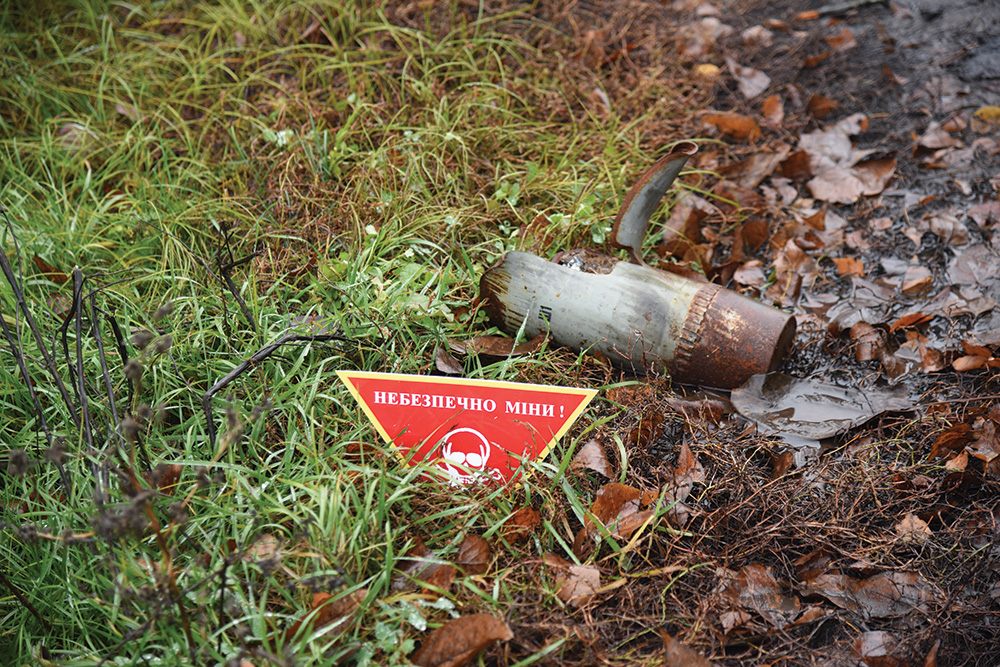
Non-technical survey in Chernihiv, March 2023.
Ongoing Challenges
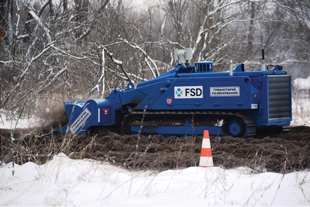
Specialized Doking MV-4 makes it possible to speed up mine clearance.
Equipment. When FSD resumed operations in mid-2022, the organization was facing a significant scarcity of the required equipment such as vehicles, trailers, personal protective equipment (PPE), and metal detectors. Despite this, FSD managed to be fully equipped by the end of November 2022. However, the ongoing expansion of operations means that equipment used for training of new staff cannot be deployed with the new teams until it is replaced, which results in delays. A variety of factors contribute to the slow arrival of additional equipment. The high demand for metal detectors and PPE for operations in Ukraine has resulted in a global shortage. Moreover, customs procedures at Ukraine’s border often take significant time, particularly for potential “dual-purpose” items such as metal detectors. Compounding these challenges, international logistics companies currently do not deliver to Ukraine, so ordered equipment must be collected in a neighboring country by Ukrainian logistics companies or directly by FSD and transported to Ukraine.

Explosive ordnance training in Chernihiv, October 2022.
Accreditation. Ukraine had already formulated national mine action standards (NMAS) before the war. However, the writers of Ukraine’s NMAS had not foreseen the unimaginable levels of EO contamination that the country is facing as a result of the Russian invasion, and consequently the document series needed to be rewritten and expanded. FSD supported the Ukrainian authorities during this crucial process, helping to develop important capacities for accreditation processes. FSD’s subsequent re-accreditation process was successful, permitting FSD to continue mine action operations in Ukraine for the next five years. However, the accreditation left out several core clearance capacities as more work needed to be done to add key NMAS documents on mine detection dogs (MDD), EOD spot tasks, and others. NMAS and accreditations for these vital work areas will allow FSD to increase the impact of its operations, for example by conducting much-needed spot tasks of surface contamination.
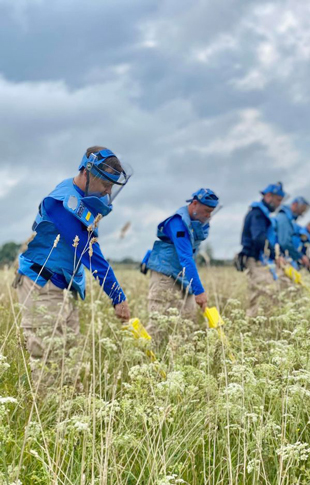
BAC teams inspecting a field in Chernihiv, September 2022.
Security. The initial Russian invasion was followed by retreats and successful Ukrainian counter-offensives. As a result, many of Ukraine’s contaminated areas lie far in the rear of the current front lines. Humanitarian mine action operations in Ukraine are therefore relatively safe from the ongoing fighting in the east of the country. Nevertheless, missile attacks and indirect fire continue to pose a threat to humanitarian workers and the Ukrainian population, and many roads in the areas in which FSD works are suspected of being contaminated with ERW and require careful checking.
Conclusion
The agricultural lands of Ukraine—Europe’s second largest country after Russia—are enormous in scale, stretching over thousands of square kilometers. With the war still raging and mine action operations still in the process of expanding and adjusting to the new realities, it appears that, at the current stage, BAC alone is insufficient to achieve rapid successes in addressing the most urgent clearance needs, particularly with respect to Ukraine’s agricultural lands and key infrastructure. Given the enormous contamination Ukraine is facing, the publication of key NMAS documents and a swift accreditation process for the use of MDDs, high risk search, and spot tasks, among others, will be an important step. This will allow FSD teams and other mine action organizations to ensure the maximum impact for the people of Ukraine.
Markus Schindler
Project Manager
Foundation suisse de déminage
 Markus Schindler is currently a Project Manager for Fondation suisse de déminage (FSD) in Iraq, where he is leading a capacity development project that aims to build the professional competence of a local mine action NGO. His experience spans nine years working with FSD in various roles spread across multiple countries, including Afghanistan, Iraq, Tajikistan, Ukraine, and the Philippines. Mr. Schindler holds a Master’s in Strategic Studies from University College Cork, a Master’s in Social Science and Ethics from Ruhr University Bochum, and a Bachelor’s in Philosophy from the University of Regensburg.
Markus Schindler is currently a Project Manager for Fondation suisse de déminage (FSD) in Iraq, where he is leading a capacity development project that aims to build the professional competence of a local mine action NGO. His experience spans nine years working with FSD in various roles spread across multiple countries, including Afghanistan, Iraq, Tajikistan, Ukraine, and the Philippines. Mr. Schindler holds a Master’s in Strategic Studies from University College Cork, a Master’s in Social Science and Ethics from Ruhr University Bochum, and a Bachelor’s in Philosophy from the University of Regensburg.
Anthony Connell
Country Director, Ukraine
Foundation suisse de déminage
 Anthony Connell is a citizen of New Zealand who served in the NZ Army for twenty-four years. He is currently the FSD Country Director in Ukraine. Mr. Connell started his mine action work in 2000 with ELS in Northern Iraq and has worked in Albania (twice), Sudan, Switzerland, Denmark, Angola, Syria/Turkey, Ukraine, and Colombia. He began working with FSD in Ukraine in 2016 and, aside from a brief sabbatical in Colombia (2019–2020), has remained in Ukraine since then.
Anthony Connell is a citizen of New Zealand who served in the NZ Army for twenty-four years. He is currently the FSD Country Director in Ukraine. Mr. Connell started his mine action work in 2000 with ELS in Northern Iraq and has worked in Albania (twice), Sudan, Switzerland, Denmark, Angola, Syria/Turkey, Ukraine, and Colombia. He began working with FSD in Ukraine in 2016 and, aside from a brief sabbatical in Colombia (2019–2020), has remained in Ukraine since then.
| Stay updated | |||

